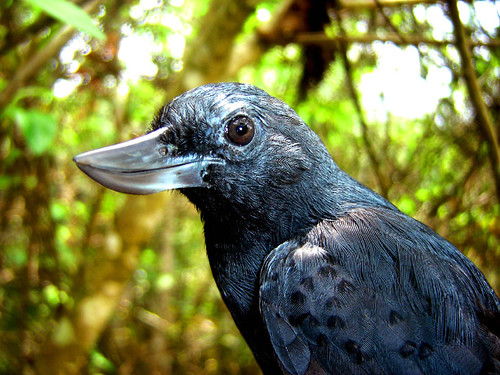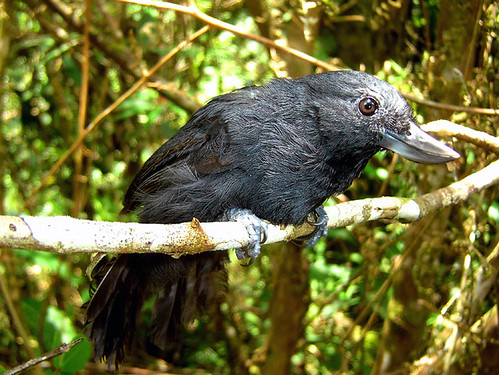tags: recurve-billed bushbird, Clytoctantes alixii, ornithology, birds, avian, endangered species
This male Recurve-billed Bushbird, Clytoctantes alixii, was recently photographed by ProAves staff, Adriana Tovar and Luis Eduardo Uruena. This is the first time this globally endangered species has been captured on film. [larger].
For the first time ever, an elusive recurve-billed bushbird, Clytoctantes alixii, has been photographed in the wild. The bird, recently rediscovered by scientists in Colombia a Colombian ornithologist named Oscar Laverde after a 40-year absence, has a heavy, upward-curving beak that gives it the illusion of an enigmatic smile.
Because of this rare bird's limited range and remote habitats, it was not seen at all between 1965 and 2004. However, the bird was recently rediscovered on a 250-acre (101-hectare) reserve next to the Torcoroma Holy Sanctuary near the Colombian town of Ocaña. The Catholic Church has protected this area since 1709, when the locals claimed they saw the image of the Virgin Mary in a tree root.
Additionally, this species was also seen recently in Venezuela and in a region of northeastern Colombia, where it was also photographed.
The Torcoroma Holy Sanctuary is a very unique area because it is a relic dry pre-montane cloud forest that is predominantly covered with bamboo forest.
Recurve-billed bushbirds are stocky passerines with a short tail and recurved bill. Males are a grey-blue color with a black breast and throat while females are rufous-brown in color. This species is sedentary, living in dense undergrowth, thickets, and forest edges in foothills forests, from 185 to 1,750 meters of elevation. It is terrestrial and forages on the ground for insects. Populations of this species are very small, and are threatened by rapid fragmentation of their habitat, which is being destroyed to develop agricultural and grazing areas.
"[A]s more and more remote areas are being settled, the bushbird reminds us how important it is to conserve as much natural habitat as we can," said Paul Salaman of the American Bird Conservancy.
"Who knows what wonderful biodiversity is being destroyed before it has had a chance to be discovered?"
Male Recurve-billed Bushbird, Clytoctantes alixii [larger]
Sources
Wildlife Extra (quotes)
National Geographic (quotes)



Hey, that's not a recurve-billed bushbird! It's an ivory billed woodpecker disguised as a recurve-billed bushbird!
Bob
It's blue!
There aren't that many birds that are blue; I thought that it was only a couple of very rare parrot species (used to be more but hunted to extinction because of their blueness), a few birds of paradise and the blue-bird of course.
It is a friendly looking bird and I do hope that the Catholic Church continues to preserve the habitat.
The catholic church is most likely to molest it!!!
But maybe with its unique face and notoriety for having "disappeared" from the radar for so many years will raise enough awareness that it will be saved.
Our own "success" as a species is really horrible. The catholic church of course can take credit for that with its progressive attitude about birth control.....
Crippler! This is one of the b-i-g ones for latin America! There are reliable sites for it and a bunch of the other endemics in West Venezuala as well. A few years ago Chris Sharpe of Pro-vita told me about seeing some parakeets, a new tapaculo, rare raptors, Gray-throated Warbler and a load of other great stuff. Which of the specialties are there? Anyone know the safety issues?
An attack on the Catholic Church is inappropriate in this forum - their service to the poor, the sick, the lost and the uneducated far surpasses that of any other human institution on the planet. If this bird can survive in this private sanctuary, we have another cause for gratitude.
check out the sound of this bird (and 2800+other species) at www.xeno-canto.org
I checked this out and this news may be a rehash. The Bushbird had been studied in Venezuala and Columbia quite a while before. I just found out that there are photographs taken several years before as well.
Check out http://www.birdlife.org/datazone/species/index.html?action=SpcHTMDetail…
Chris Sharpe writes:
...I don't know to this day who stumbled upon the Bushbird first - whether us or the Colombians - but I suspect they might have had the edge as they were making much more thorough and systematic efforts than we were. On our side, it was basically an obsession and, apart from a CI grant for a 2004 trip, we were self-financed. As for the photographs, I certainly have earlier ones: I took several dozen of a pair of Bushbirds in April 2004. I assumed at the time that they were the first, but who knows?
Nice, BUT it should be notet that it was not ProAves who re-discovered this bird species. It was another Colombian ornithologist named Oscar Laverde, who guided ProAves to the place for them to look at it.
Any idea what the selection pressures were for the beak to attain that shape? My first guess would be a unique feeding method but I also wouldn't rule out something odd in the prey species.
more about this story from Chris Sharpe, who originally re-discovered this bird.